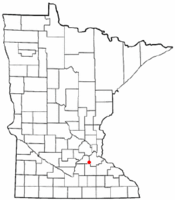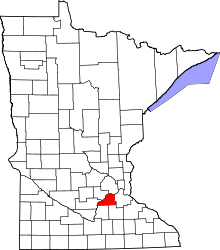Elko New Market, Minnesota
| Elko New Market, Minnesota | |
|---|---|
| City | |
 Location of the city of Elko New Market within Scott County, Minnesota | |
| Coordinates: 44°46′04″N 93°16′39″W / 44.76778°N 93.27750°W | |
| Country | United States |
| State | Minnesota |
| County | Scott |
| Founded | 1856 (NM) |
| Established | 1858 (NM) |
| Merged | 2006 |
| Government | |
| • Type | Mayor-council government - Executive form |
| Area[1] | |
| • City | 3.36 sq mi (8.70 km2) |
| • Land | 3.36 sq mi (8.70 km2) |
| • Water | 0 sq mi (0 km2) |
| Elevation | 971 ft (296 m) |
| Population (2010)[2] | |
| • City | 4,110 |
| • Estimate (2013)[3] | 4,513 |
| • Density | 1,223.2/sq mi (472.3/km2) |
| • Metro | 3,279,833 |
| Time zone | CST (UTC-6) |
| • Summer (DST) | CDT (UTC-5) |
| Area code(s) | 952 |
| GNIS feature ID | [4] |
| Website | City website |
Elko New Market is a city in Scott County in the State of Minnesota from a merger of bordering cities Elko and New Market in 2006. The population was 4,110 at the 2010 census.[5]
Served by Interstate 35 and Scott County Road 2, the city contains one public school Eagle View Elementary, and is primarily known for Elko Speedway. The New Market Hotel and Store is on the National Register of Historic Places. New Market contains a marker for the Big Woods of south–central Minnesota.[6]
New Market is named for the town near Cambridge, England though it was first named Jackson until its establishment in 1858.[7] Elko was initially a railway village about the same time. Both Elko and New Market were common town names of the era according to the Minnesota Historical Society.
History
On March 21, 2006, both the cities of Elko and New Market passed a referendum to merge. The new city was named Elko New Market with the merger taking effect on January 1, 2007.
Geography
Located midway between the cities of Minneapolis and Faribault along Interstate 35, Elko New Market is in the southern exurban belt of the Minneapolis – Saint Paul area. Burnsville and Lakeville are near Elko New Market.
According to the United States Census Bureau, the city has a total area of 3.36 square miles (8.70 km2), all of it land.[1]
Demographics
| Historical population | |||
|---|---|---|---|
| Census | Pop. | %± | |
| 2000 | 3,972 | — | |
| 2010 | 4,110 | 3.5% | |
| Est. 2015 | 4,705 | [8] | 14.5% |
| U.S. Decennial Census[9] 2013 Estimate[3] | |||
2010 census
As of the census[2] of 2010, there were 4,110 people, 1,259 households, and 1,064 families residing in the city. The population density was 1,223.2 inhabitants per square mile (472.3/km2). There were 1,328 housing units at an average density of 395.2 per square mile (152.6/km2). The racial makeup of the city was 92.5% White, 1.6% African American, 0.3% Native American, 3.1% Asian, 0.2% from other races, and 2.2% from two or more races. Hispanic or Latino of any race were 2.3% of the population.
There were 1,259 households of which 60.4% had children under the age of 18 living with them, 73.9% were married couples living together, 6.3% had a female householder with no husband present, 4.3% had a male householder with no wife present, and 15.5% were non-families. 9.5% of all households were made up of individuals and 0.9% had someone living alone who was 65 years of age or older. The average household size was 3.26 and the average family size was 3.53.
The median age in the city was 30.4 years. 38% of residents were under the age of 18; 4.6% were between the ages of 18 and 24; 39.5% were from 25 to 44; 15.1% were from 45 to 64; and 2.7% were 65 years of age or older. The gender makeup of the city was 50.9% male and 49.1% female.
Sports venues
References
- 1 2 "US Gazetteer files 2010". United States Census Bureau. Retrieved 2012-11-13.
- 1 2 "American FactFinder". United States Census Bureau. Retrieved 2012-11-13.
- 1 2 "Population Estimates". United States Census Bureau. Retrieved 2014-07-19.
- ↑ "US Board on Geographic Names". United States Geological Survey. 2007-10-25. Retrieved 2008-01-31.
- ↑ "2010 Census Redistricting Data (Public Law 94-171) Summary File". American FactFinder. United States Census Bureau. Retrieved 27 April 2011.
- ↑ Sarah P. Rubinstein (2003). Minnesota History Along the Highways: A Guide to Historic Markers and Sites. Minnesota Historical Society Press.
- ↑ Minnesota Historical Society (1920). Collections of the Minnesota Historical Society. MN Historical Society.
- ↑ "Annual Estimates of the Resident Population for Incorporated Places: April 1, 2010 to July 1, 2015". Retrieved July 2, 2016.
- ↑ United States Census Bureau. "Census of Population and Housing". Retrieved February 12, 2014.
External links
Coordinates: 44°33′53″N 93°19′37″W / 44.56472°N 93.32694°W
